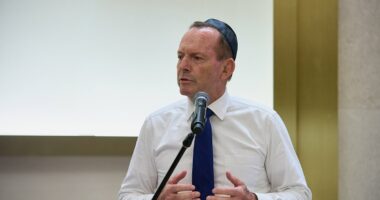Share this @internewscast.com
Australia finds itself in the throes of a housing crisis that is transforming the nation in unexpected ways, potentially setting the stage for significant political shifts. What was once a straightforward issue of housing affordability has morphed into a full-blown crisis, with the median house price having skyrocketed from $192,000 in the year 2000 to nearly $1 million today.
As the dream of home ownership becomes increasingly elusive, many young Australians are making profound lifestyle adjustments. Parenthood is being postponed, car ownership is being reconsidered, and financial independence is sacrificed, often requiring assistance from ‘the Bank of Mum and Dad’ to make ends meet. These changes are quietly altering the dynamics of love, family, and politics, reshaping the very fabric of the Australian way of life.
One might expect that such financial pressures would lead to an increase in relationship breakdowns, given that financial stress is frequently cited as a key reason for marital discord. Surprisingly, the opposite trend is observed. Despite the cost of living crisis, divorce rates have plummeted to their lowest since the no-fault divorce was introduced in 1976.
It’s quietly rewriting the rules of love, family and politics, and effectively reshaping the fabric of the Australian way of life.
Divorce rates falling but love isn’t the glue
With financial stress often cited as a major factor in relationship breakdowns, it stands to reason that the cost of living crisis would drive divorce rates higher.
The opposite has occurred. The rate of divorce is at its lowest level since the introduction of no-fault divorce in 1976.
But for many, it’s not about staying together for love – rather it’s about keeping a roof over their heads.

Divorce comes with obvious costs – lawyers, moving, and most significantly, running two households instead of one
For many, the prospect of joining the difficult search for two homes in Australia’s overheated, understocked housing market is more daunting than staying with a soulmate who now resembles an insufferable flatmate.
University of Sydney economics lecturer Luke Hartigan co-authored a study that found lower house price growth increases the likelihood of separation, while higher-than-expected growth discourages it, especially among low-income households, women with lower education, and older couples.
He said the consequences of soaring house prices and their relationship to marriage and divorce have largely been ignored, with the trend unlikely to subside if property prices continue to rise.
‘We found the likelihood of divorce was typically more pronounced for high-education and high-income couples with children,’ he said.
‘We also found divorce was more likely for couples with a mortgage as well as younger couples.’
Renters abandoning the major parties

In 1987, less than two per cent of Australians voted for third parties. At the last election, it was one in three voters. (Prime Minister Anthony Albanese is pictured)
The rising cost of living is reshaping how Australians vote, with housing affordability now one of the most decisive issues in federal elections.
Home ownership has been steadily declining for decades, with nearly one in three Australians now renting. Alarmingly, three out of five renters believe they will never be able to afford a home of their own.
Futurologist Rocky Scopelliti said that, for the first time, young Australians are not expecting to live better than their parents – they’re expecting to live smaller.
‘As younger Australians realise they are inheriting both a broken housing market and an ageing fiscal system, the sense of intergenerational inequity is deepening,’ he said.
‘That disillusionment has political consequences.’
Historically, homeowners have leaned conservative while renters skew progressive, notes Professor Scopelliti. But when ownership itself becomes unattainable, new political identities emerge.
‘This could explain the rising volatility of younger voters and the increasing appeal of minor parties or independent movements,’ he said.

Futurologist Rocky Scopelliti (pictured) said the housing crisis is shifting voting habits
‘The next political realignment in Australia may not be left versus right, it may be own versus rent.’
Demographer Simon Kuestenmacher said that in 1987, less than two per cent of Australians voted for third parties. At the last election, it was one in three voters.
He predicts that within a few election cycles, we may well see a prime minister from outside Labor or Liberal.
‘If home ownership doesn’t become much more affordable soon, the third parties will continue to gain ever more votes,’ he said.
Priced out of parenthood
Australia’s fertility rate has fallen to its lowest level on record, as steep rents and mortgage repayments delay major life decisions such as starting a family.
Australian Bureau of Statistics (ABS) data shows the total fertility rate dropped from 1.84 births per woman in 2000 to 1.48 in 2024, well below the replacement rate of 2.1.
Analysis by KPMG attributes the decline primarily to economic pressures, noting changes in disposable income have a significant impact on the nation’s birth rate.
Urban economist Terry Rawnsley said rising rents, mortgage payments and childcare costs in metropolitan areas are putting a handbrake on people’s parenthood plans.

For many married couples, staying together is a financially necessity as the cost of living bites (stock image posed by models)
He said Perth had previously done the heavy lifting when it came to driving Australia’s population growth, but the increase is still well below pre-pandemic levels.
‘Perth’s relatively strong fertility rate is driven by the fact its housing market is still much more affordable compared to the east coast,’ he said.
‘Young families can find a decent-sized block much closer to the city than they can in Sydney or Melbourne, for just a fraction of the price.’
ABS head of demography Beidar Cho said in 2024 the median age of mothers was 32.1 and fathers was 33.9, showing a slow but steady increase over the past decade.
‘This shift toward older parenthood reflects broader social changes and economic shifts,’ she said.
‘This includes things like more time spent in education such as university and TAFE and higher workforce participation by women.’
Australians racing the biological clock, turning to IVF
The soaring cost of property has become a silent macroeconomic force behind the boom in Australia’s assisted reproduction industry, with UNSW data revealing one in 16 babies is now born via IVF.
Among women aged over 35, that figure rises to nearly one in 10.
As couples spend their prime fertile years saving for a home and building careers to cover rising living costs, many are delaying parenthood and facing a ticking biological clock.

Emily Gentles has spoken of her struggles to conceive Eloise (pictured) after delaying parenthood
This trend is driving a surge in couples seeking IVF, often undergoing multiple costly rounds of treatment.
Melbourne mum Emily Gentles defied the odds to become a parent at 43.
After multiple failed IVF rounds and a heartbreaking miscarriage, motherhood felt out of reach. But two years later, she welcomed baby Eloise without medical intervention.
‘Building a career and more importantly not being with the right partner until this age were the main reasons [for] the delay in trying to have a baby,’ she said.
‘However, as soon as we made the decision to try for a family, we were greeted with statistics that made it feel like a near-impossible task.
‘After six months of trying naturally, we embarked on an IVF journey as we were told, “At your age, this is really your only viable option.”‘

Professor Georgina Chambers (pictured) said it’s a common misconception that IVF can easily solve infertility
Professor Georgina Chambers, director of UNSW’s National Perinatal Epidemiology and Statistics Unit, said it’s a common misconception that IVF can easily solve infertility.
‘For each fresh or frozen IVF cycle started in 35-year-old women, the live birth rate is around 30 per cent,’ she said.
‘This drops to 15 per cent for a 40-year-old and 10 per cent for a 42-year-old.’
We’re unhappier
Australia’s housing crisis is not just an economic issue – research shows a clear link between housing stress and rising levels of psychological distress.
The HILDA survey has been asking Australians every year since 2001 to recall how often they felt happy, joyful, sad, tired or depressed in the last month.
In 2013, less than one in five Australian men and women reported they had experienced distress.

More than one in four women reported being in distress in the annual HILDA survey
Fast forward a decade, and more than one in four women (27.5 per cent) and nearly one in four men (22.8 per cent) reported being in distress, an increase of roughly 50 per cent.
The largest increase in psychological distress was reported for those aged 25 to 44.
The Salvation Army’s Red Shield Report 2025 found 71 per cent of people experienced housing stress and 33 per cent feared homelessness.
According to advocacy group Everybody’s Home, renters now need to earn $130,000 a year to afford an average unit.
It’s not just renters feeling the squeeze.
Sydney, Melbourne, Brisbane, Adelaide and Perth were named among the top 15 most unaffordable places in the world to buy a home in the 2025 Demographia International Housing Affordability Report.
Everybody’s Home spokeswoman Maiy Azize said tax breaks that inflate house prices and lock people out of home ownership must be wound back.
‘Every year, billions of taxpayer dollars are handed to property investors through negative gearing and the capital gains tax discount, with everyday Australians paying the price,’ she said.

Sydney (pictured) was named the second-most impossibly unaffordable city in the world, only behind Hong Kong
‘These tax breaks are among the most unfair and distortionary in our economy. They make housing less affordable, benefit higher-income Australians, and lock everyday people out of safe and affordable housing.’
Small business feels the squeeze
There’s a strong link between Australia’s surging property prices and the mounting challenges faced by small businesses, with half of the businesses launched in 2019 closing their doors by 2023.
In major urban centres like Sydney, Melbourne and Brisbane, commercial property prices and rents have soared, stifling the nation’s 2.7 million small businesses from thriving and surviving.
According to the ABS Counts of Australian Businesses, 370,500 small businesses closed in the last financial year, a 21 per cent increase from pre-pandemic levels.

There’s a strong link between Australia’s surging property prices and the mounting challenges faced by small businesses, as commercial rents have soared
Nearly half (49.3 per cent) of those businesses are owned or operated by individuals or families.
While traditional storefronts and offices face mounting pressure from rising rents and a workforce increasingly drawn to remote work, a different kind of workspace is thriving: the virtual office.
Remote work adoption has accelerated this shift, allowing companies to operate without the burden of expensive physical office space in prestigious districts.
Virtual office services in Sydney CBD towers like Barangaroo and Melbourne’s Collins Street start at just $19 a month for a basic address, and can climb to $600 for full-service packages that include mail handling, receptionist support and access to meeting rooms.
Large dog breeds are vanishing from our cities
Declining housing affordability has driven many Australians, especially younger renters and apartment dwellers, towards higher-density urban living.
This shift, coupled with rising costs, has led to a preference for smaller, lower-maintenance pets such as cats, small dogs or fish over larger dogs, which require more space, according to a report by Animal Medicines Australia.
It found that while overall pet ownership remained high (69 per cent), the proportion of households with larger dogs has declined, while cat ownership has risen.

Large dog breeds like golden retrievers are becoming less common in Australian cities
And as the nation struggles through a cost-of-living crisis, there’s been a surge in pet surrendering, with rescue shelters reporting that large dog breeds are becoming homeless more than any other pet.
RSPCA animal operations general manager Kristy Blake said that in the past year alone, there was a 52 per cent spike in animals waiting to enter its shelters simply because their families can no longer afford to care for them.
If housing is the foundation of a stable society, then Australia is building on shaky ground.
Professor Scopelliti said Australia’s housing crisis is a psychological and cultural fault line running through the heart of the nation.
‘When a generation loses its stake in housing, it doesn’t just lose financial security, it loses emotional security,’ he said.
‘The Australian dream has long served as a social contract between generations. That contract is being rewritten, and the next generation wasn’t invited to the table.’

















